#King Kukri Machete
Text




If desired, you can “add sharpening” as an option to the purchase these machetes if you would like for us touch-up and improve the default factory blade edge and make it sharper.
Yoshimi Machete
Warlok Machete
King Kukri Machete
#Kult of Athena#KultOfAthena#Condor#Yoshimi Machete#Warlok Machete#King Kukri Machete#machete#machetes#sword#swords#weapon#weapons#blade#blades#Modern Tactical Swords#Modern Tactical Weapons#Modern Swords#Modern Weapons#Tactical Swords#Tactical Weapons#Kydex#MOLLE#knife#knives#Knives & Daggers#Korean Philippine & S.E. Asian Weapons#Korean Philippine & S.E. Asian Knives & Daggers
3 notes
·
View notes
Text
An old writing prompt: describe 10 swords under certain limitations, try not to repeat descriptors.
10 swords
-no more than 20 words
-no starting with the same word
-name of the sword is part of the 20 words
1)
Scimitar — Slices and dices! Not for kitchen use.
2)
Cutlass — Cuts lads as well. Beloved by brigands.
3)
Hawk's Talon — Once used by a hero who could do a three-hit air combo (combo skill not included).
4)
Excavator — Some say this wide, flat blade was once used to unearth lost treasures.
5)
Cemetery — It's been bandaged up, but it still cuts like a dream.
6)
Wooden Sword — Never leave home without it! Your mom wishes you would cut it out.
7)
Pincushion — Awkwardly named for what the opponent will become when you unleash a flurry of stabs with this weapon.
8)
Kitchen Knife — Lovingly honed before every use, this knife will last you ages… in the kitchen.
9)
Ladle — Shockingly hot to the touch. Blow on it first, or you'll burn your tongue!
10)
Mara's Embrace — Gifted by the Demon King, it never leaves your side… for better or worse.
11)
Nameless Edge — An unsigned katana, the kind exported en masse to appeal to a certain crowd.
12)
Blue Devil — One cut can chill its victims to the bone. Two cuts and they're basically popsicles!
13)
Flamberge — Despite the name, it has no flame-based powers. Has a cool, wavy edge.
14)
Epee — Longer and heavier than other fencing swords, this model was modified by its last user.
15)
Lil Cactus — What a cute lil guy! Doesn't mind you swinging him around.
16)
Triplicate — Two blades not cutting it? We've got you covered. Hits thrice in one attack.
17)
Three-Handed Sword — For guys who don't like to be outdone by Triple Swordsmen. Can be wielded in two hands.
18)
Crowspike — Blackened by heat and bearing a wicked point, this icepick has a sinister presence.
19)
Bronze Longsword — Balanced weapon for new adventurers. The large crossguard makes it easy to parry with.
20)
Soulbiter — Cursed like you wouldn't believe. Retrieved from the fallen Black Knight, but its eyes still move…
21)
Laser Blade — Hold the wide end away from you and flip the switch. Bwooom! Make sure to keep it charged.
22)
Kukri — This forward-curving blade is excellent for cutting through foliage and a favorite for those bored by machetes.
23)
Photon Saber — Bahamut's blessing has imbued this bladeless hilt with a miraculous blade of light.
24)
Comet Knife — Forged out of meteor steel in the mountain town of Biwa. Possesses a dazzling, oily sheen.
25)
Brave Blade — A true hero's sword! Gets weaker if the wielder has ever fled from battle.
26)
Ballista — Greenswallow the Phalanx made his debut in battle by swinging around this siege weapon with a bayonet.
27)
Flesh Diver — Twitches eerily in your hand. The blade snaps apart and leaps towards its prey before returning.
28)
Fruitsbane — Tools like this are commonly used to peel apples or chop bananas.
29)
Spatha — Leaves symbolize the boundless gift of life. As such, the decorative wreathe supplies its owner with increased stamina.
30)
Tenfold Oaths — Flexibility is the pride of a knight. Squires can only draw out a few of its myriad forms.
5 notes
·
View notes
Text
Lost Tomb Lewks, Part 4
(Masterpost) (Other Canary Amusements)
Warning: vague Spoilers for Season 1 of The Lost Tomb Reboot
Look 17 is this gorgeous knife.
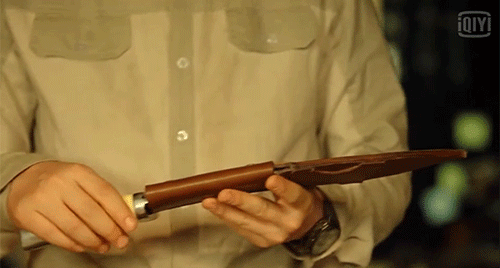
I’m not a “knives are sexy” person, or I should say, I never WAS a “knives are sexy” person before.

I do have a strong affection for my Alaskan ulu kitchen knife, which is a godsend for anyone who is arthritic (me) or who is an upper-limb amputee (my family member) or is hemiplegic (different family member), but that’s as much attention as I’ve ever paid to a knife.
Until now:
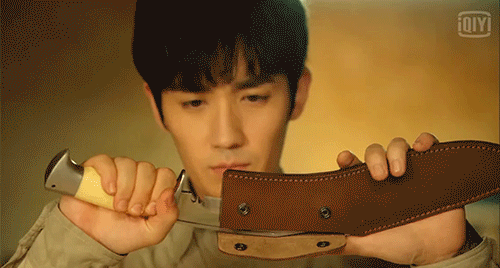

(*whisper* lick it)
Ahem.
This is a kukri, a traditional knife of the Gurkha people in Nepal and India. It’s similar to a machete but it has a downward-curving blade, which means you can slash downward forcefully without bending your wrist. It’s excellent for cracking crustacean shells heavy chopping, as well as combat. Wikipedia doesn’t know why there are notches near the base of the blade but sure does have some theories.
The handle looks to be a mix of metal and ivory. Hopefully antique ivory, or ivory from a properly-compensated voluntary donor. [That is a joke, the ivory trade is bad, don’t kill elephants, etc.] The case is topstitched leather with snaps to keep the knife from escaping. Did OP just spend an hour learning too much about knives? She did. Does this mean she’s going to also make an effort to learn something about watches, a critically overlooked area of her menswear commentary? It does not.

Look 18 is a classic explorer’s rig that looks like it came out of the Banana Republic catalog back in 1987 when the name “Banana Republic” still kind of suited the clothes sold there. (Google it and be startled) This look features dark brown trousers that are comfortably loose but still well-fitted and flattering. The shirt is two warm tans--a dark one for most parts, and a lighter one through the chest and inner arms. This gives it a nice depth and keeps it from looking bland. This outfit also features Wu Xie’s watch, which...is round? and tells time.
(more after the cut!)
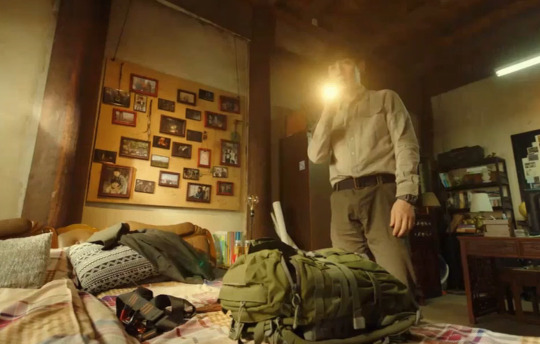
This look features the first of many, many, many times that a character will shine a flashlight directly into the camera. Which makes it painful to watch the show on my tablet in the dark when my bedmate is asleep. Knock it off, characters!

Side Note: Wu Xie’s room has some good features. He’s got a giant bulletin board holding framed photos of all the adventures in which he was played by a different actor. This makes it easy to move his photo collection when his uncle decides to be a dick about the rent.
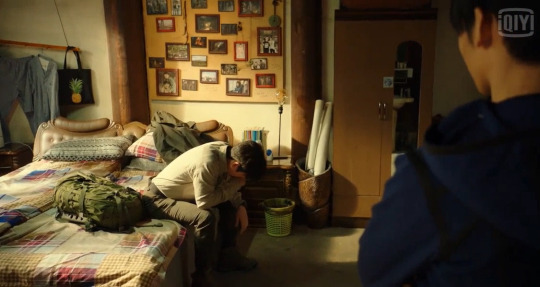
Wu Xie’s bed is big and comfy-looking, with a variety of patterns and textures; appropriate for a person who’s planning on dying, or having an increasingly complicated love life, or both. This bed has room for a 100-year-old boyfriend, a 20-year-old girlfriend, and a thousand-year-old crustacean-brained princess, as long as everyone’s friendly.
It also has a padded headboard, which is so important when you are dating a paper-mache person with a fragile head. This padded headboard also has curved head/neck support things that look just the right size for a person to grab onto with both hands and hold on for dear life. It looks antique, which means Wu Xie bought it for the aesthetic value and definitely not for fucking, right? Definitely not. For fucking.
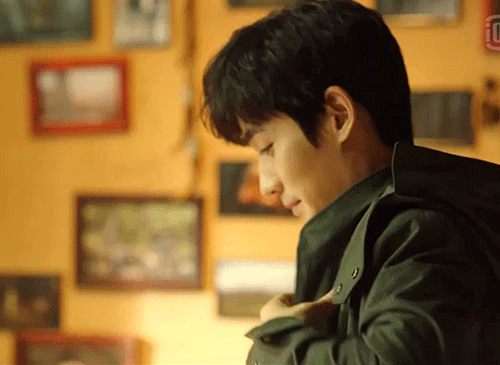
Wu Xie tops off Look 18 with the handsome swamp green coat from their recent tomb adventure, now completely unmuddy thanks to the world’s greatest dry cleaner, and with a strappy, practical backpack.
This warm-toned outfit and the buttery colors of the room are perfect for having an intimate, deeply truthful conversation...
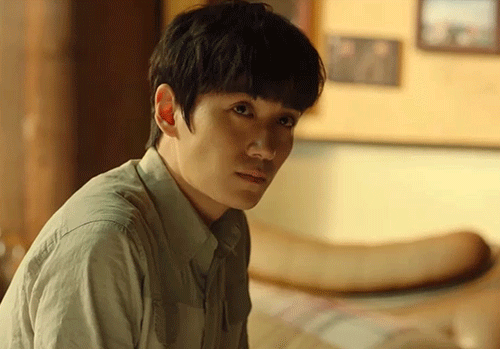
....in which you gently crush your dear one’s heart into powder.

Look 19 is Xiao Ge’s blue hoodie and black pants combo, which we finally get to see in the full light of day.
The hood is good for hiding in when you want to cry.
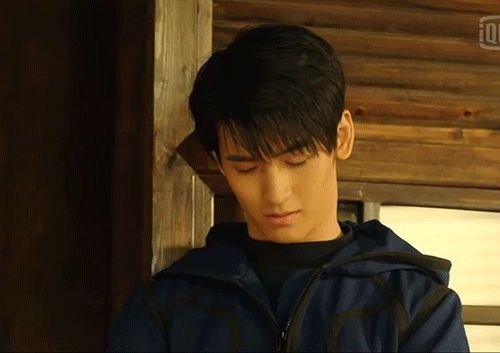
This hoodie looks black in low light, but is actually navy blue with black piping, placket, and zipper.
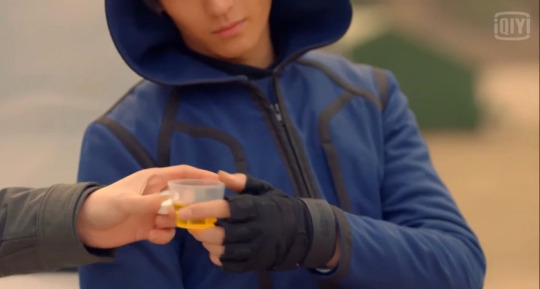
The ensemble features black trousers with an eye-catching vertical silver-toned zipper on the front pockets. Black boots and black tactical gloves round out the look.
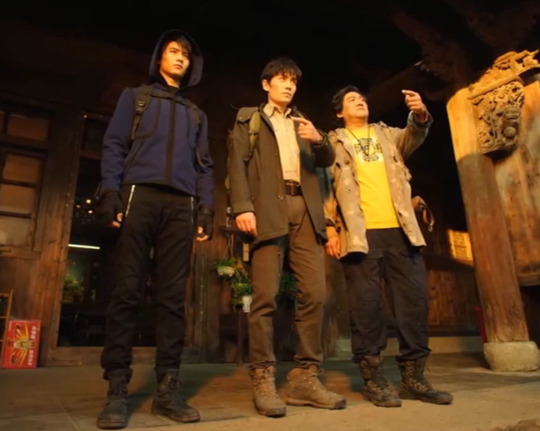
Side note: each of the Iron Triangle guys has his own backpack style. Wu Xie’s is an olive green expedition pack. Pangzi’s is two-tone canvas and leather.
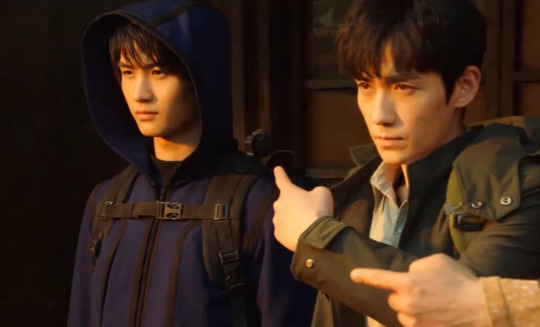
Xiao Ge’s is black tech fabric, and features a chest strap to keep it from shifting around when he is kicking asses. The black straps coordinates well with the black piping on his hoodie.
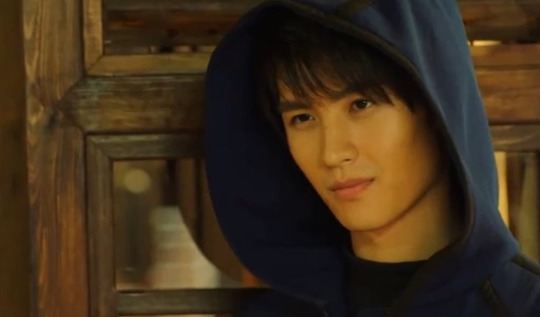
This outfit is a good one to wear while you exchange tender gazes of pure unconditional love with the guy who is crushing your heart into powder.
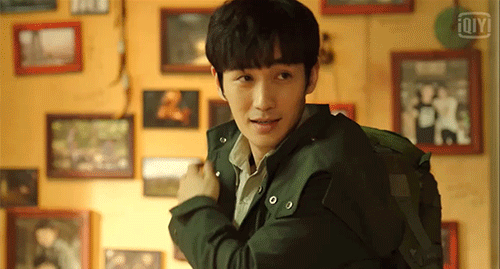

I don’t need to look at Pangzi I know what Pangzi looks like and anyway I glanced at him already today.

Did OP slow these gifs way down purely to keep from giving anybody eye strain? She did. OP is considerate of your eyes. Speaking of eyes, awww. Xiao Ge sure is bros with Wu Xie, you guys.
Look 20: Liu Sang! Liu Sang! Liu Sang!
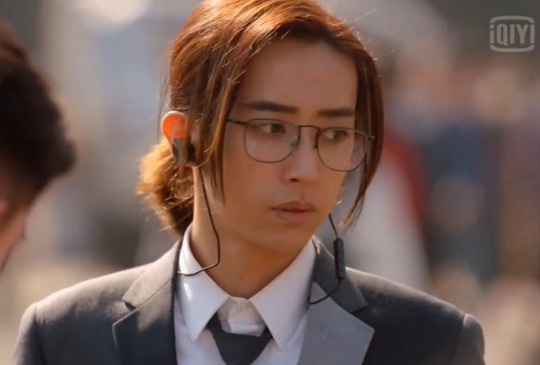
Actor Liu Chang, a man who can wear literally anything and make it look fucking amazing, makes his entry onto the scene in a good, but understated, suit.

Most of the suit is a charcoal grey, but it has a single light grey lapel and pocket flap, to keep things interesting. He’s wearing it with black Oxford shoes that have a small red, white, & blue tab poking out the back. So he’s dressed conservatively, but with a bit of flair.
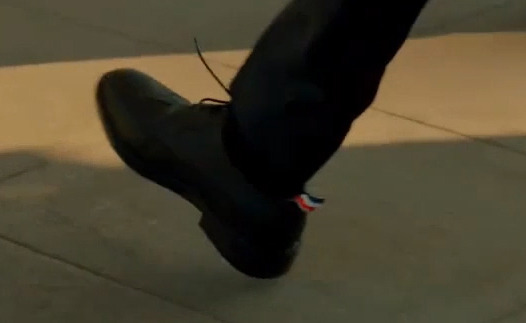
He’s accessorized the look with perfectly fine, but not very interesting, black wirefame glasses that he’ll replace with cooler ones after some time underground. He’s got a cartilage piercing in his left ear with a flat black oblong earring. Because of his extreme hearing, he’s wearing noise-cancelling earphones.

This look says, “normalize the use of adaptive tech.” These are probably - in real life - not as effective as the larger over-ear headphones a lot of noise-sensitive people use, but their sleekness and elegance match the rest of Liu Sang’s accessories and clothing.
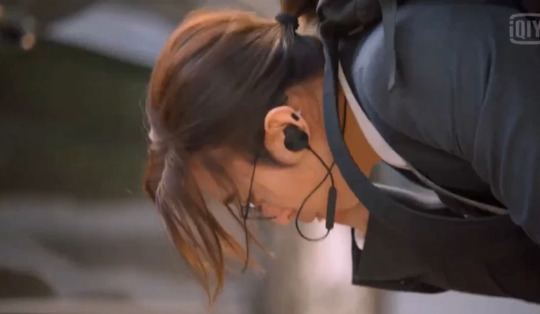
Because of his noise sensitivity, Liu Sang pukes as soon as he gets out into the crowded street. He vomits neatly into a drain, however, in the way of someone who’s used to managing this symptom and isn’t going to let it spoil his outfit. We stan a neuroatypical king.
More Lewks coming soon!
#the lost tomb reboot#reunion: the sound of the providence#liu sang#zhu yilong#liu chang#lost tomb lewks#wu xie#canary3d-original#don't worry I haven't forgotten restless rewatch#I just had to write about the knife first#the kniiiiiffffeeee#spoilers
104 notes
·
View notes
Text
The Lycanthrope King
“Tiny” was the smallest person in her small Louisiana town. She was fourteen but was the size of a sixth grader. Four foot, nine inches and ninety pounds of small, fearless adventure. Her real name was Susanne, but everyone called her “Tiny”. She hated the name, but her only real friend used it as a compliment instead of an insult.
Tiny’s friend, Jimmy, was her complete opposite. She called him “Big”. Big and Tiny were inseparable, adventurous, and fearless. Big was actually huge. Six foot, six inches and three hundred pounds of big, mean, and strong.
These two loved exploring the woods and loved learning about nature. Tiny always carried a slingshot and pouch of glass marbles with her. Big carried a large kukri knife and a pair of smaller, sharp throwing knives on his belt. Each had their own backpack with adventure supplies. Rope, water, first aid, and other supplies.
Big would sometimes carry Tiny across deep creeks or have to cut through the deep brush. That was the usual. That day’s unorganized routine was different, though. Tiny’s father, Daryll, had gone missing three weeks ago and the search parties had given up. Big and Tiny hadn’t, and they wouldn’t. Big knew this meant a lot to her.
“We’ll find him, Tiny. I promise you.” Big’s voice was soft and deep. Calming.
Tiny didn’t say anything and kept walking. She was usually a happy child, but this had sent her spiraling into a deep sadness. She stopped when she heard a noise. Running and a twig snapping. The crunch of leaves. Tiny put a marble in her pouch and drew back the band. She was an excellent shot with her slingshot.
Big drew his kukri and stood defensively at Tiny’s side. “In the treeline, at the edge of the swamp.” Big saw it, but he didn’t quite know what it was.
Tiny saw it, too. She knew her shot would hit from this distance, but not accurately. She relaxed her shot and progressed forward towards the creature. It knew they were there. Big had hunted all of his life and he knew something wasn’t right.
“Tiny, it knows we see it. What is it?” Big asked softly. He wasn’t scared, but he wanted to protect her more than anything.
Tiny turned to look up at him. “I don’t know what it is, but I need to follow it. I need to find my father. I need to see if he is dead or lost.” In the back of her mind, she knew that somehow that thing was connected to her father’s disappearance.
Big looked down at her and gave it some consideration. “Fine, but I'm leading the way.” With that, he stepped in front of her and looked up. The thing was gone.
Big stopped moving and looked around in front of him. It only took a couple of seconds for the thing to vanish. The swamp began about a hundred yards in front of them. They heard a howl-like yell come from the swamp and Big looked back at Tiny. She looked solid. Unresponsive to the creature’s noises.
Big felt eyes on him, not just the birds or the Gators. He knew it was watching them. As he progressed forward, the ground became muddier. Harder to walk through. Any farther and they would become stuck.
“We need to turn back.” Big said, slowly turning towards Tiny, “We can come back when the water recedes.”
Tiny nodded and trudged through the mud and water to the dry woods and dirt. Big sheathed his machete and looked around for a place to wash off. His pants and boots were wet up to his knees, and just as muddy. He found a deep creek over by them and he led the two of them over to it.
“Come on, I’m going to go wash this mud off.” Big took off his pack and his weapons and walked out into the creek, rubbing the mud out of his jeans.
Tiny walked up to the bank and observed the fish and turtles in the creek. She heard deep, growling behind her. Tiny turned and saw it. The eyes reminded her of her father’s. She froze, everything around her slowing down. The thing huffed at her, breathing heavily. She thought it was her father.
“Dad?” She asked, reaching up to touch its face.
Big looked up and saw Tiny on the bank up ahead and was going to yell to her when he realized the monster was in front of her. He took off towards the bank, splashing through the water and pushing through the sand. He started to run over to her, yelling at her to get back as he went.
“Suzanne! Get back!” Big yelled and stood in front of the monster. “Run back!” He commanded. Tiny stepped back and kept a few feet away.
The monster was leaning down to Tiny’s face, and when Big came up, it stood. Aggressively. Big looked it in the eyes and it snarled at him. Big felt a sharp pain in his right side and then the ground hit him. The initial impact knocked the wind out of him, but then the ground brought him back to feeling. He looked up at the monster as it approached Tiny and he saw it.
The thing was tall and hairy, with the head of a wolf and a man-like body. Tiny looked scared. For the first time in her life, she was. Big, on the other hand, was just angry. He stood and spit, advancing on the monster. It had thrown Big farther than he thought and with a large, hard fist, Big punched it in the head. Big had knocked down huge men with a punch like that, but the thing seemed unfazed by that.
It simply turned and slashed Big across the face with its claws, and kicked him away. Big flew into the ground and felt pain all throughout his back. Tiny was shaking, her hands trembling as she drew back the band on her slingshot. She loosed a shot but was shaking so badly that she missed and hit a tree behind the thing. It turned and grabbed her by the neck, snarling at her as it took off with her.
“Jimmy!” Tiny screamed as she fought the creature that carried her away.
“Suzanne...” Big breathed out as he struggled to stand again.
Big made his way over to his gear and noticed that his side was bleeding. He lifted up his shirt. Nothing. It wasn’t his side that was bleeding. It was his face. Big dug into his pack and found the box he was looking for. Medical supplies and a small mirror.
He pulled the mirror out of the box and looked at his face. The right side of his face was scratched badly. Big was concerned about his eye. It was fine, though narrowly missed by the claws of the beast. He cleaned his wounds the best he could, but it hurt very much.
Big packed up and took after the screams that he heard. It felt like miles, but he eventually caught up with the thing. It looked like it slept here. Big saw someone lying near the nest, off to the side. It was shaking and sobbing. He slowly approached it. It was Tiny. She was lying next to her father’s mutilated corpse.
He had been ripped open and torn apart. He was missing his right arm, left hand, and both legs. His skin was grey and green. His body had been here for a long time. Weeks, maybe. One thing was odd about his body other than the missing limbs. His eyes were gone.
Big felt sad. Daryll had always been so kind to him. He had been a good man. Big heard heavy footsteps behind him and he whipped around, drawing his machete as he did. Big met the monster with great anger and deep hatred. Tiny stood up, feeling nothing. Numb and cold to anything around her.
The monster roared at Big, and Big roared back. He was furious. The monster drew back its arm to swat him, but Big was fast. He cut the hand off and when the thing tried to bite him, Big hit it over the head with the pommel of his kukri and it stepped back. Big charged it, driving it to the ground and beating it with his knife.
Big went to stab it in the chest when a glass shot hit it in the snout. The thing roared out in pain and threw Big off, focusing now on Tiny. She loosed another shot into its ribs and another into its thigh.
“Make it suffer, Jimmy,” Tiny said coldly and kept shooting it with the marbles in the most painful areas. “It will meet the same fate as my father.”
Big cut off the creature’s arm and it screamed. Ungodly and inhumane, the two of them tortured the monster until Tiny ran out of shot. Big cut off one of its legs with several swings, making sure it felt as much pain as possible. He hacked off the other, getting progressively angrier as he cut. It squirmed and writhed as Big cut it into pieces.
“I want its head! I want to hang it on my wall so I can laugh every time I see it!” Tiny was angry. She was enjoying this.
“Suzzane. Doing that won’t bring Daryll back. I’m fine with cutting it up, but making it a trophy won’t bring him back.” Big stabbed into its chest, straight into its heart. It was dead.
“Give me your knife! Now! I need this, Jimmy.” Tiny was upset, tears streaking down her face.
“No.” With that, Tiny tried to shove him. She was upset and hurt.
“Suzanne. Stop.” Big was looking down at her. His best friend.
Tiny shoved him again and she started to punch his stomach. Big endured this, and he let her try and tire herself out. She eventually gave up and collapsed, falling to the ground with a grunt.
“Are you done?” Big asked and sat down by his companion.
Tiny just nodded and looked over at the thing for a few minutes. Those minutes seemed, to Tiny, a millennium of discordant seconds. Strange, but familiar. She stared into the open eyes of this monster they tore apart and she felt a creeping feeling of regret. Big observed his surroundings. Nothing. Dead silence.
He sensed more eyes on him. Sensed more danger. Big began to realize something: There were more of them. He saw them through the trees. Through the bushes and tall grass. Big heard the howling begin. First one, then two, and more and more. There had to be a dozen of them.
“Run! Now!” Big stood quickly and drew his machete, but he saw that the monsters weren’t attacking. They seemed to regard him with caution. They were smelling him.
The monsters were crouching, seemingly submitting to their new alpha. The first one to approach him knelt in front of Big, looking up at him. Big put away his kukri and reached out to pet the thing. It was soft and warm and fluffy like a dog. It wasn’t friendly, however. It snarled after a few moments and bit him on his arm, tearing into his bicep muscles.
Big grunted and started to punch it in the side of the head. It eventually let go, backing away from him and Big looked at his arm. Tiny watched that happen but didn’t move. She couldn’t. Big was now defenseless. He used his machete with the injured arm, but he still squared up to the thing. It backed away.
Big, after a few minutes, started to feel nauseous. He soon collapsed and could feel his body heating up. He writhed to get his shirt off. His gear. His skin was hot to the touch and he started to feel a sharp pain inside his chest cavity. Big yelled and felt his limbs stretching out.
This caused him immense pain, but he somehow endured it. Big felt his face contorting, the bones breaking and reassembling themselves all over his body. He managed to look at his arms and chest. Hair. A lot of it. He was becoming one of them. Big looked at Tiny and tried to say something.
“I’m so sorry, Suzanne.” came out as nothing more than a distorted growl.
Tiny stepped back from him and watched him get up. Big couldn’t remember anything. There was a cloud of smog in his head. He now stood well over eight feet tall and no more than five hundred pounds. Tiny was terrified. She snatched one of his daggers and held it out, point facing him.
Big looked at the small human in front of him and sniffed her. He was friendly. She seemed familiar to him, and he licked her face. Tiny dropped the dagger and started to pat his head. Big could smell her fear. He could smell her blood, running through her veins. It made him hungry.
Big looked her in the eyes and growled. He bore his teeth at her and bit down on her throat. He grabbed her head in his hand and ripped back. This tore out her throat. The screaming stopped. Just a low gurgling now. He began to rip her open, spilling her stomach contents onto the ground. A look of fear permanently frozen on Tiny’s face.
He stood, still holding her corpse in his hand and he howled. He felt better than he ever had. Big couldn’t remember anything, but he knew how to kill. How to hunt. How to eat. He threw her body over by the other one. Big watched all the others of his newfound family step out of the shadows and kneel. He was the alpha. The Lycanthrope King.
1 note
·
View note
Link
Knives have been used as weapons, tools and utensils since time immemorial. For most of recorded history – more than 99 per cent of man’s time on earth – knives were the difference between life and death. When you think of it, it is the most basic human tool, the one tool that more than most (if not any) others connects us to our ancestors. We needed knives to defend ourselves against wild animals and to hunt and clean them for food. So, it’s not a stretch to say that knives have played a major part in the survival of our species. But, today, carrying a knife is not accepted in society. They are seen as weapons, when historically knives have always been tools first and weapons second.
The initial knives were made from stone and wood, but that all changed as we entered the Iron Age, about 3,500 years ago. This period was marked by the creation of iron tools and, most significantly, the iron knife. The iron knife was a huge step up over any previous version of the tool. Later, carbon was added to iron to bring about iron alloy steel. The introduction of steel enhanced the quality of the knives no end. Today, steel has become the standard for blades. An interesting thing to note is that while the quality of knives have no doubt improved over the centuries, basic processes such as blacksmithing, forging and tempering have remained largely the same. The other major innovation with regard to knives has been the invention of the folder around 1400 AD. While the folder remains essentially the same, some technical advancements have been added over the last six centuries, such as handle material, grinds, serrations, etc.
In the past, knives came in handy during dinner time, as it served the purpose of a fork. However, this practice was viewed as a danger to the hosts as well as the guest’s own well-being – it was easy to cut one’s mouth with a sharp knife, especially when inebriated. However, once forks started gaining acceptance as a safer way to picking food, there was no need for the “dinner knife.” It was the French monarch King Louis XIV who, in 1669, decreed that all pointed knives be deemed illegal. Duly, all knife points were ground down, in an effort to reduce violence. This gave birth to blunt knives with wider and rounder ends which made it convenient to use in combination with the two-pronged fork. Also, knives were designed with a blade which curved backwards, which made it easy to get food to the mouth.
Today, most countries have a knife related to their history and culture, which has greatly enhanced the hobby of collecting knives. The Philippines has the long, slim bolo knives that are perfect to cut sugarcanes in the jungle. The heavier South American machete is ideal for cutting down dense forest vegetation. The Gurkhas have the curved Kukri. And America’s contribution to this global catalog is the famed Bowie Knife.
The knife continues to be a vital tool, though more for recreation than self-defense as in the past. These days, you can purchase high-quality knives from a range of manufacturers in a wide variety of styles and materials.
1 note
·
View note
Note
If the Champions get melee weapons instead of ranged ones, which weapon would they use?
Barik: A wrench.
Fernando: A very classy sword, preferably superheated.
Torvald: Just his fist. Just punch people.
Ruckus: Bolt will also punch people.
Makoa: An ancient sword imbued with magic.
Drogoz: Machete.
Bomb King: A royal staff made of gold with a poppy bomb mounted on the top, and it’s encrusted with jewels.
Viktor: Tomahawk
Tyra: Combat dagger
Cassie: Serrated knife
Kinessa: Kukri
Sha Lin: Dual rune blades
Evie: Still her staff, but it’s not capable of magic
Skye: Shuriken
Buck: Fists
Androxus: Scythe
Mal’Damba: Staff of Wekono
Pip: Throwing knives
Grover: Wooden staff
Grohk: His usual staff, but incapable of electricity
Ying: Fighting fans
12 notes
·
View notes
Text
MRINAL'S MAGIC-The Creator !
Vegetarian food is the ultimate choice of the future world...
Tuesday, August 16, 2011
Khukri
Nepalese Khukuri
About Khukuri
Thursday, June 30, 2011Nepali khukuri
Nepali khukuri
The Khukuri (gurkha knife), a semi-curve metal knife, is synonymous with the valor of legendary Gurkha soldiers. Though Khukuri is national knife of Nepal, it has not famed only within Nepal or Gurkhas but it has gained popularity in the world, as it is one of the most practical, convenient and peculiar knives. Bowie knife, Stiletto, Scimitar, Roman Sword, Samurai or Machete are some of the famous knives of the world and have all played a great historical significance because of their cutting edge over other weapons. But the most famous of them is the 'Kukri'!
History of Khukuri:
Khukuri(kukri), a semi-curve metal knife, is synonymous with the valor of legendary Gurkha Army. Though Khukuri(kukri) is national knife of Nepal, which has not famed only within Nepal or Gurkhas(Gorkha) but it has gained popularity in the world, as it is one of the best practical, convenient and peculiar knifes. Bowie knife, Stiletto, Scimitar, Roman Sword, Samurai or Machete are some o the famous knives of the world and have all played a great historical significance because of their cutting edge over other weapons. But the most famous of them is the \'Kukri or khukuri
Khukuri(kukri) is a semi curved metal knife and each Gurkha soldier carries with him in uniform and in battle/war. During the 1st and 2nd world wars, khukuri was famed as a non- exploded bomb or grenade. In times past, khukuri(kukri) was said that once a Khukuris(kukris) was drawn in battle, it had to \'taste blood\'- if not, its owner had to cut himself before returning into its sheath.
In the hands of an experience wielder the khukuri(gurkha knife) is about a formidable a weapon as can be conceived. The lithe wire little men, utterly courageous, supremely cheerful, stealthy as leopards and agile as goats in the mountains, come leaping over the ground to attack, moving so quickly. When they come near the enemy, they suddenly crouch to the ground, drive under the bayonets and strike upward at the men with their Khukuri(kukri), ripping them open in a single blow. The result of such a dangerous combination of man and blade is a superb and effective slaughter. The enemy tumbles in two clean pieces, even before he can express his surprise because his is the kindest, quietest and quickest death.
The Khukuri(kukri), however is more than just an enemy\'s nightmare. From its origins as a valuable farming implement, the Khukuri(gurkha knife) evolved over the centuries into a lethal fighting weapon. To most of Nepal\'s rural people, who constitute more than 90% of the Country population, the Khukuri is a best friends, a multi-purpose knife which can be used for cutting grass, chopping wood, peeling vegetables, slaughtering animals and skinning meat, not to mention warding off dangerous animals and the occasional human invader. People of Nepal traditionally carry the Khukuri when traveling out door, just the sight of the brazen knife is enough to scare off most robbers. More than being just a revered and effective weapon, however, the Khukuri(gurkha knife) is also the peaceful all-purpose knifes of the hill people of Nepal. It is a versatile working tool and therefore an indispensable possession of almost every households and travelers.
The Khukuri(gorkha knife) is also used in sacrificial ceremonies: during Dashain, within the Gurkha(Gorkha) regiments, the Khukuri(kukris) is used to cut off animals\' heads to make pleasure the gods and goddesses, who in return will protect Gurkhas(Gorkha) in battle. Those Nepalese who do not participate in blood-letting slash a pumpkin instead. The Khukuri(khukuris) is then garlanded with flowers and blessed with or without the animal\'s blood.
This \'all purpose\' knife of the Gurkhas(Gorkha) - \'Khukuri\' is of a very peculiar shape. Basically, the standard blade (Service No.1 kukri) is very thick at the base measuring a little more than a quarter of an inch in thickness. From the back it is thinned off gradually to the edge, which has curvature of its own, quite different to that of the back, so the blade is widest as well as thickest in the middle, and tapers at one end towards the hilt and at the other end towards the point. The point of the Khukuri(kukri) is a sharp as a needle, so that the weapon answers equally for cutting as well as stabbing. In consequence of the great thickness of the metal the blade is exceedingly heavy. A blow from such a weapon can be a terrible one, the very weight of the blade, if allowed to fall from a certain height, would drive half way through the arm of a person.
The Khukuri or kukri has never been broken in battle. Not a surprising claim, considering that the knife is made only from high grade steel often taken from a railway line or truck spring. A Khukuri(gurkha knife) handle is usually made from rosewood, buffalo horns or metals such as Aluminum, Brass in some cases Ivory and Antler also utilize for making the handle. The common scabbard is made from leather or wood and often features various carved designed. The \'top man\'s\" Khukuri incorporates exquisite etchings and engravings on the blade in addition to a gold or silver scabbard (Kothimora) which is inlaid with even more precious gems.
Most Khukuris(kukris) feature two little knives attached at the back of the sheath held either in a built-in pocket or a leather purse. The small sharp knife is a Karda. Besides being used to hone the master blade, it serves for small cutting jobs. Perhaps the most unusual task it has is at the time of a child\'s birth: the Karda is then used to cut the umbilical cord. Afterwords the knife is place at the side of the cot to ward off evil spirits. The other knife is called a Chakmak. It is blunt and once rubbed against a stone will produce enough sparks to start a fire. Who needs electric lighters?
The Gurkha(Gorkha) and his Khukuri(kukri) are incomplete without each other. Together they\'ve earned their fame, which can never to be forgotten. Finally, whatever be the roots, Nepal, the Gurkhas and the Khukuri are inseparable in reputation.
--------------------------------------------------------------------------------
The Origin of Khukuri:
None of us knows the fact that how the Khukuri(kukri) was exactly originated and where it was developed. The originated place and date have also been lost in the mists of time. Even the spelling has been disputed or butchered since someone first tried to describe this knife: khookree, kookerie, khukri, kukery, Kukoori, Koukoori, kukri. What we see is an Anglicized version of a word first heard by English ears back in the early 18th century. The spoken word is actually 3 syllables: kook-er-ee and has finally come down to today’s accepted spelling of kukri or Khukri. Thus, name of this knife can be spelt and pronounced numerous ways but the most common names are Kukri or Khukuri.
Here are some facts, which prove that it is one of the oldest knives in the world. The blade shape descended from the classic Greek sword of Kopis, which is about 2500 years old.
A cavalry sword (The Machaira, Machira) of the ancient Macedonians which was carried by the troops of Alexander the Great when it invaded northwest India in the 4th Century BC and was copied by local black smiths or Kamis some knife exports have found similarities in the construction of some Khukuris to the crafting method of old Japanese sword. Thus the making of Khukuri is one of the oldest blade forms in the history of world, if not in fact the oldest.
Some says it was originated from a form of knife first used by the Mallas who came to power in Nepal in the 13th Century. There are some Khukuris displaying on the walls of National Museum at Chhauni in Kathmandu which are 500 years old or even more among them one belonged to Drabya Shah, the founder king of the kingdom of Gorkha, in 1627 AD But the some facts shows that the Khukuri\'s history is centuries old then this. But other suggest that the Khukuri was first used by Kiratis who came to power in Nepal before Lichchhavi age, about 7th Century.
--------------------------------------------------------------------------------
Some Mystical Meaning of Khukuri:
Another thing that adds to the magic of the Khukuri is the cultural and religious significance that has worked its way into the knife. Among the more unique features of the Khukuri is the crescent moon-shaped notch at the base of the blade. Some say it is a fertility symbol or a lock for securing the Khukuri(kukri) in its sheath. Others say it is to interrupt the flow of blood down onto the handle, which would make it wet or slippery during the time of attack. Perhaps the most plausible explanation is that it is a simple defensive feature of the knife, for once the blow of an opponent\'s weapon is caught on the blade, the sword or dagger slips down into the notch where with one quick twist, the opponent is disarmed. The notch of the Khukuri(kukri) near the hilt is said the trident of the Hindu god Shiva, the god of war and destroy. It has various other meanings such as a cow tract, the sexual apparatus of Hindu gods and goddesses, the sun and moon, the symbol of Nepal.
--------------------------------------------------------------------------------
The History and Meaning of the Khukuri:
None of us knows the fact that how the Khukuri (Khukri or Kukri) was exactly originated and where it was developed. The originated place and date have also been lost in the mists of time. Here are some facts, which proves that it is one of the oldest knives in the world. The blade shape descended from the classic Greek sword of Kopis, which is about 2500 years old. The Machira, the calavry sword of the ancient Macedonians which was carried by the troops of Alexander the Great when it invaded northwest India in the 4th Century BC and was copied by local black smiths or Kamis. Some knife exports have found similarities in the construction of some Khukuris(kukris) to the crafting method of old Japanese sword. Thus the making of Khukuri(kukri) is one of the oldest blade forms in the history of world, if not in fact the oldest.
Some say it was originated from a form of knife first used by the Mallas who came to power in Nepal in the 13th Century. There are some Khukuris displaying on the walls of National Museum at Chhauni in Kathmandu which are 500 years old or even more among them one belonged to Drabya Shah, the founder king of the kingdom of Gorkha, in 1627 AD But the some facts shows that the Khukuri\'s history is centuries old then this. But other suggest that the Khukuri was first used by Kiratis who came to power in Nepal before Lichchhavi age, about 7th Century.
An another thing that adds to the magic of the Khukuri(kukri) is the cultural and religious significance that has worked its way into the knife. Among the more unique features of the Khukuri is the crescent moon-shaped notch at the base of the blade. Some say it is a fertility symbol or a lock for securing the Khukuri(kukri) in its sheath. Others say it is to interrupt the flow of blood down onto the handle, which would make it wet or slippery during the time of attack. Perhaps the most plausible explanation is that it is a simple defensive feature of the knife, for once the blow of an opponent\'s weapon is caught on the blade, the sword or dagger slips down into the notch where with one quick twist, the opponent is disarmed. The notch of the Khukuri(kukri) near the hilt is said the trident of the Hindu god Shiva, the god of war and destroy. It has various other meanings such as a cow tract, the sexual apparatus of Hindu gods and goddesses, the sun and moon, the symbol of Nepal.
--------------------------------------------------------------------------------
There are two names for this knife that are now universally accepted, “Khukuri” or “Kukri”. After going through series of names since someone first tried to speak, pronounce or write when it was first encountered or discovered in the early 1600’s “Khukuri” became the strict Nepalese version that is very common, famous and household name in Nepalese literature. However Khukuri is more known as “Kukri” in the western world and beyond which we see is an anglicized version of the British when they first discovered the knife.
With khukuri’s origin going back to ancient times, the khukuri(kukri) is not only the national knife of Nepal but is also symbolic of the Gurkha soldier, a prized possession with which he has indelibly carved an identity for himself. The khukuri(kukri) has been the weapon of choice for the Gorkhas of Nepal and the famous Gorkhali Sainik of King Prithivi Narayan Shah since 16th century and used for almost everything from a utility tool to an effective fighting knife in battle to a unique piece of decoration that has marked its amazing reputation. The successful war campaigns and swift victory of the Gorkhali Sainik against its enemies must be credited to some extent to this unusual and practical weapon. It is also believed that the universal custom of Gurkha Army carrying the khukuri(kukri) began from Gorkhali Sanik(Gorkha soldier) and that was later made an important part of military issue under the British ownership. This custom still exists although the size and type of khukuri have significantly changed and improvised.
The khukuri is a medium-length curved knife each Gurkha soldier carries with him in uniform and in battle.In his grip, it is a formidable razor-sharp weapon and a cutting tool. In fact, it is an extension of his arm. When his rifle misfires, or when his bullets have run out, a Gurkha unsheathes his khukuri and makes his final \"do-or-die\" run on the enemy in a fury to finish the business. This scene created the romance and the legends. What he really did, and still does with his khukuri(kukri), is a super-clean slaughter: The enemy tumbles down in two clean pieces- and in surprise! - because his is the kindest, quietest death because it is the quickest.
At present, khukuri(kukri) is recognized as the national knife of Nepal. Known more than being just a revered and effective weapon, the khukuri(kukri) is also the peaceful all-purpose knife of the hill people of Nepal. It is a versatile working tool and therefore an indispensable possession of almost every household, especially of those belonging to the Gurung, Magar, Rai, Limbu and Tamang ethnic groups of central and eastern Nepal. A Nepali boy is likely to have his own khukuri at the tender age of five or so and necessarily becomes skilful in its usage long before his man hood. It is also likely that the boy will have painful encounters with his khukuri(kukri) but his belief and bonding in the process with the khukuri(kukri) will teach him how to use and respect it. Moreover, apart from the fact that the khukuri(gurkha knife) is an exceptionally effective tool that denotes a strong character, it also symbolizes bravery and valor and is a Nepalese cultural icon, it also represents an exquisite piece of Nepalese craftsmanship and is indeed a unique memento for you to take back home from Nepal.
The construction of khukuri(gurkha kukri) is very basic and simple yet it has style and class of its own. In Nepal people still use very traditional and primitive method and conventional tools to make it. In early Nepal most villages would have a metal smith or famously known as “Kamis” who forged khukuirs(kukris) to their best ability. In today’s context there is a good deal of mass production done in a organized and systematic way where Kamis from different places come together under the same shade and work for a contractor who is responsible for all management, business and financial activities.
The khukuri blades have always varied much in quality. Inferior and high quality steels both have been equally used thus needs an expert eye and skill to distinguish one from the other.
Old heavy vehicles spring (suspension) steel has always been the source of a good quality khukuri(kukri) blade. Khukuris(kukris) in the earlier days were much longer than the modern ones and significantly varied in shape and size than its contemporary siblings; and also had steel fixtures. Army khukuris issued to the Gurkhas during the World War era had stampings like name of manufacturer, inspection date, issue date and sometimes name of the military unit. Khukuris(kukris) were than longer and more curved than the current issues. Along with traditional and village khukuris(kukris) even the army knives have intensely changed over the years to adapting to the modern times and its developments.
Khukuri(gurkha kukri) grips are normally made from local walnut wood called “Sattisaal” in Nepalese, domestic water buffalo horn and some very fancy from brass, aluminum; and even ivory and rhino horn are used for some very special ones. Basically two types of tang are applied; one is the rat-tail tang that goes all the way through the handle narrowing its surface area as it finishes towards the end of the handle and its end/tail is penned over and secured. The other is the full flat tang that also goes through the handle but the tang can be seen on the sides of the handle and steel rivets are fixed to secure the handle to the tang and a pommel plate or butt cap is also fitted at the end to enhance the total fixture; this type is called as “Panawal Handle”. Most of ancient khukuris used to have wooden handle with rat tail tang however, surprisingly, the tail did not come all the way through the handle. The handles were curved unlike the modern ones and had steel or iron fixtures in most cases. The exact origin or who initiated the “Panawal” handle is not known but probably started in early 1900’s when Kamis were influenced by British Knives and they undertook the new better version. It is also likely that the handle demanded better treatment as rat tail handle were not strong enough to hold the long blades when put hard on job. Today different materials are used in the khukuri and are improvised to better suit the demands of today and for better results nonetheless traditional styles have been retained except for a few exceptional and unique ones.
The khukuri is carried in scabbard, “Dap” in Nepalese, where normally 2 pieces of wooden frames are covered with water buffalo hide or other domesticated animal parts and may or may not have brass or steel protective chape depending on the type of khukuri. Khukuri scabbard like the blade and handle has come a long way with many changes and modifications along the way to keep up with the ever changing time and need. Scabbards from early days did not have belt frog and people used untreated untainted raw leather hide just for the mere shake of carrying the Khukuri blade. Khukuri were thus stuck in the owner’s sash or “Patuka” as frogs or any sorts of holder were missing. After the formation of British Gurkhas frogs were introduced by British to carry khukuri from waist belt and later steel and brass fixtures were used to look good and also to protect the naked tip of the scabbard. Some khukuris have decorative scabbard with beautifully well done wooden, horn, silver, brass work and sometimes ivory. Khukuri that are especially intended for display purpose, are given extra time and effort to its scabbard by using horns, wood and other expensive decorative materials crafting beautiful designs and carvings with traditional and religious symbols in the scabbard. It is a customary in Gurkha Army to present a retiring officer with a Kothimoda khukuri (silver case) to honor his outstanding long and loyal service to the regiment and the country. Khukuri scabbard also has two pockets at the back that carry blunt steel called “Chakmak” for sharpening the khukuri blade and also for striking sparks from flint and a little sharp knife called “Karda” used as a small utility knife. Very old scabbards along with Karda and Chakmak also had an extra leather pouch (Khalti) attached to it used for carrying small survival kits or most of the time small piece of flint to create a spark with the Chakmak. However, army khukuris in world war days and most khukuris in 19th and early 20th centuries did have neither the Karda Chakmak nor the extra pouch. It is only after the mid 20th century Karda and Chakmak were again placed back in the Gurkha knives to maintain the khukuri tradition. Most khukuri at present have Karda Chakmak however Khalti is ignored.
Shapes and sizes of khukuris from ancient to modern ones have varied intensely from place to place, person to person, maker to maker and so forth. Khukuri made in the Eastern village Bhojpur, very famous for khukuris, make fat thick blade where as Sirupate, the most famous khukuri in Nepal is very slim and thin. Similarly khukuris from Salyan are long and slender with deeper belly and Dhankuta, a village in the east make simple standard army type blade but gives emphasis on the scabbard by making it decorative and ornate. Khukuris made during the 18th and 19th century was much longer and more curved than its modern counterparts. The shapes were often very broad belly and heavy or very curved slender and thus very light. Only the standard army issue were and are made of the same dimension and measurement in order to bring uniformity and tidiness to the unit; where as local khukuris still continue to vary from one another making it impossible to characterize or distinguish a particular khukuri from the rest. Moreover, since all khukuris are totally handmade even the same type and version tend to differ a bit leaving the impression of the habitual of the maker and his individuality.
--------------------------------------------------------------------------------
KUKRI/KNIFE:
--------------------------------------------------------------------------------
The Khukuri (kukri) is carried in scabbard (dab in Nepali) usually made of wood covered in leather with a protective metal cap over the tip. Most handles are made of wood. The \"dab\" may sometimes be adorned with cloth-work or engraving and hilt made of bone ivory, horn or metal. All Khukuris (kukris) have two pockets at the back of the scabbard, which hold blunt steel called \"chakmak\" for sharpening the blade or for striking sparks from flint and a little knife known as \"karda\" used for skinning small game or as a penknife. The notch (kaura) in the blade near the hilt of most Khukuris (kukris) serves as a conduit for the blood on the blade to drip out thus prevents it from soiling the hilt, as well as a device for catching and neutralizing an enemy blade. It also represents the Hindu fertility symbol. The Khukuri(kukri) is not only the national knife but also has great religious importance and is worshipped by the Nepalese during the grand Hindu festival Dashain.
The Gurkha is worthy of notice, if only for the remarkable weapon which they use in preference to any other. It is called the \"Khukuri\" or \"Kukri\" and is of a very peculiar shape. As may be seen by reference to the drawings both the blade and hilt are curved.
The kukri blade is very thick at the back measuring a little more than a quarter of an inch in thickness. From the back it is thinned off gradually to the edge, which has curve of its own, quite different to that of the back, so the blade is widest as well as thickest in the middle, and tapers at one end towards the hilt and the other towards the point. The steel of which the blade is formed is of admirable temper, as is shown by the fact that specimens which had not been cleaned for thirty years, but have been hung upon walls among other weapons, are scarcely touched with rust, and for the greater part of their surface are burnished like mirrors.
The point of the Khukuri or Kukri is as sharp as a needle, so that the weapon answers equally for cutting or stabbing. In consequence of the great thickness of the metal, the blade is exceedingly heavy. It may be imagined that a blow from such a weapon as this must be a very terrible one. The very weight of the blade would drive it half through a mans arm if it were only allowed to fall from a little height. But the Gurkhas have a mode of striking which resembles the \"drawing\" cut off the broad sword, and which urges the sharp edge through flesh and bone alike.
To make a complete set every Khukuri or Kukri must come with two small knives at the back. The two smaller knives used are of very similar form, but apparently of inferior metal. These are kept in little case attached to the side of the Khukuri or Kukri sheath, just as is the case with the knives attached to a Highlander\'s dirk.
In the hands of an experienced wielder this Khukuri or Kukri is about as formidable a weapon as can be conceived. Like all really good weapons, Khukuri\'s or Kukri\'s efficiency depends much more upon the skill that the strength of the wielder and thus it happens that the little Gurkha a mere boy in point of stature, will cut to pieces of gigantic adversary who does not understand his mode of onset. The Gurkha generally strikes upwards with the Khukuri or Kukri, possibly in order to avoid wounding himself should his blow fail, and possibly because an upward cut is just the one that can be least guarded against.
\"When we were engaged in the many wars in India, the Gurkha proved themselves our most formidable enemies, as since they have proved themselves most invaluable allies. Brave as lions, active as monkeys, and fierce as tigers, the lithe wiry little men came leaping over the ground to attack moving so quickly, and keeping so far apart from each other, the musketry was no use against them. When they came near the soldiers, they suddenly crouched to the ground, dive under the bayonets, struck upwards at the men with their Khukuris or Kukris, ripping them open with a single blow, and then, after having done all the mischief in their power, darting off as rapidly as they had come.
Until our men learned this mode of attack they were greatly discomfited by their little opponents, who got under their weapons, cutting or slashing with knives as sharp as razors, and often escaping unhurt from the midst of bayonets. They would also dash under the bellies of the officer’s horses, rip them open with one blow of the Khukuris or Kukris, and aim another at the leg of the officer as he and his horse fell together.
The Gurkhas- Bravest of Brave
“As I write these last words, my thoughts return to you who were my comrades, the stubborn and indomitable peasants of Nepal. Once more I hear the laughter with which you greeted every hardship. Once more I see you in your bivouacs or about your fires, on forced march or in the trenches, now shivering with wet and cold, now scorched by a pitiless and burning sun. Uncomplaining you endure hunger and thirst and wounds; and at the last your unwavering lines disappear into the smoke and wrath of battle. Bravest of the brave, most generous of the generous, never had country more faithful friends than you".
The words of Professor Sir Ralph Turner, MC, who served with the 3rd Queen Alexandra's Own Gurkha Rifles in the First World War
Introduction of Gurkhas:
Beyond the borders of South Asia, Nepal is renowned for two things. One stands rock-solid and has barely moved in millennial. The mountains can’t come to them, so people come from all over the world to encounter the heart-stopping Himalaya.
The other moves around quite a bit. Most people around the world would prefer not to encounter them at any time, in any place under any circumstances- the equally heart-stopping Gurkha Soldiers. The Gurkhas rank at the top of the list of the world’s all-time most formidable fighting men. Ounce of ounce only nitroglycerine packs more devastating power. No berserkers they, but it is highly inadvisable to disagree seriously with them, individually or collectively. This, it is widely accepted, would be as fool-hardly as attempting to embrace a running chainsaw.
Rare is the person today who has not heard of the Gurkha soldiers, the brave troops from Nepal's isolated hills who bolster the forces of the British and Indian armies. Famed for their tenacity and loyalty in warfare since the late 18th Century, these Kukri-wielding soldiers underscored their fame by playing a key role in the 1982 Falkland Islands (Islas Malvinas) crisis.
Apart from “Big Boy” and “Fat Man,” the atomic superstars of the Second World War, three weapons shared top billing as the most famous: the Ju-87 “Stuka”, the U.S. armed force’s quarter-ton “Jeep” and the “Khukuri”, the knife of the Nepalese of the British Gurkha Brigade.
Gurkhas has equipped with modern SA80 Rifles and are renowned as natural marksman. But they still carry into battle their traditional weapon - a 16" long curved knife known as Khukuri. In time past, it was said that once a Khukri was drawn in battle, it had to taste blood' - if not, its owner had to cut himself before returning into its sheath.
The name, Gurkha, is a military touchstone, evoking deeds of bravery and daring-do. The image is of a solid chunk of mountain man wielding a razor-sharp Khukuri whose breadth is only matched by his grin. And the reality is only a little removed from the legend. For the Nepali, serving in a Gurkha Regiment is one of the greatest opportunities life can offer. For a Briton lucky enough to serve with such a regiment, there is no greater privilege; it is an experience that is never forgotten.
Apart from “Big Boy” and “Fat Man,” the atomic superstars of the Second World War, three weapons shared top billing as the most famous: the Ju-87 “Stuka”, the U.S. armed force’s quarter-ton “Jeep” and the “Khukuri”, the knife of the Nepalese of the British Gurkha Brigade.
Gurkhas has equipped with modern SA80 Rifles and are renowned as natural marksman. But they still carry into battle their traditional weapon - a 16" long curved knife known as Kukri. In time past, it was said that once a Khukuri was drawn in battle, it had to taste blood' - if not, its owner had to cut himself before returning into its sheath. The name is a military touchstone, evoking deeds of bravery and daring-do. The image is of a solid chunk of mountain man wielding a razor-sharp Khukuri whose breadth is only matched by his grin. And the reality is only a little removed from the legend. For the Nepali, serving in a Gurkha Regiment is one of the greatest opportunities life can offer. For a Briton lucky enough to serve with such a regiment, there is no greater privilege; it is an experience that is never forgotten.
--------------------------------------------------------------------------------
Origin of Gurkhas
Nepal is the homeland of world famous Gurkhas and the country of great Himalayas. The original definition of the Gurkhas or Gorkhali (Nepali Terms), literally meaning 'defender of cows', was a man of Mongolian stock from the ancient principality of Gorkha about fifty miles to the west of Kathmandu, whose ruler, Prithivi Narayan Shah, formed the Gorkhali army, for the first time By the help of the brave Gorkhalis from Gorkha, King Prithvi Narayan Shah succeeded in uniting modern Nepal into one Kingdom around 1768-69 AD.
The war against the British in 1814 and separate action against Tibet, early 18th century, the Gorkhalis Army was enveloped in a long-drawn battle with mercantile British East India Company. It was the Anglo-Nepal war that first thrust the myth and legend of Gurkha bravery into Western minds. In that conflict, British in India first experienced the effectiveness, stubbornness, loyalty valor and indomitable bravery of Gurkhas. Impressed by what they had seen, the British East India Company began recruiting Gurkhas into their service. The British did not formalize Gurkha recruitment until 1886, but by the time India already had eight Gurkha Rifles units. Most of the men were drawn from the Magars, Gurungs tribes, but others came from the Rais, Limbus and Sunuwars of the eastern hills and from the Khasas of the west. Over the next 50 years, the Gurkhas fought all over south Asia, From Afghanistan to Malaya, and even as far as African Somaliland in 1903.
--------------------------------------------------------------------------------
The First World War:
At the outbreak of the First World War in 1914 beckoned the Gurkhas to new destinations. With the advent of the First World War, Gurkhas were called on in even greater numbers. More than 114,000 Gurkhas were called into active service in Givenchy, Ypres, Gallipoli, Palestine, Mesopotamia, Suez, Persia and Afghanistan. Another 200,000 men were mobilized in the Indian Army. A battalion of the 8thGR (8th Gurkha Rifle, name of battalion) distinguished itself at Loos in Flanders, fighting nearly to the last man. The 6th Gurkhas won fame in the ill-fated Gallipoli campaign when they threw the Turks back in their sector. They were the only allied troops to reach and hold the hillcrest line, looking down on the straits, which were the force’s ultimate objective. Two Gurkhas - Kulbir Thapa (France 1915) and Karna Bahadur Rana (Palestine, 1918) were awarded the Victoria Cross for their Gallantry.
--------------------------------------------------------------------------------
The Second World War:
In the Second World War, Gurkha strength was expanded to 45 battalions. Soldiers saw action in Iraq, Persia, Cyprus, Tunisia, Italy, Greece, Burma, Malaya and Indonesia.
When the Second World War broke out in 1939, the Gurkhas again came to Britain’s aid. Some 112,000 men served in 45 battalions in battles in Italy, Greece, Tunisia, Persia, Iraq, Malaya, Singapore, and Burma (Myanmar). Ten Victoria Crosses were awarded to Gurkhas. In addition, the Nepalese government gave money to buy military equipment to help those made homeless in London by the Blitz. The strength of the relationship between the Nepalese and the British forces was illustrated in 1940 after the fall of France, when British requested permission to recruit a further 20 battalions, The Nepalese Prime Minister replied: “Does a friend desert a friend in time of need? If you win, we win with you. If you lose we lose with you.”
--------------------------------------------------------------------------------
Post-war action:
Two years after the Second World War ended, with the granting of independence to India, the Gurkhas regiments were divided. Six of the ten regiments became the Indian Gurkhas Rifles; the four (2ndGR, 6thGR, 7thGR and 10GR) remaining the British Brigade of Gurkhas. In India the troops plunged immediately into the India-Pakistan conflict over Kashmir; later came the Sino-Indian war (China-India) or 1962 and further battles between India and Pakistan in 1965 and 1971.
The British Brigade served in Malaya (Malaysia), Indonesia, Brunei and Cyprus. Another Victoria Cross, (the 13th) was awarded to Lance Corporal Ram Bahadur Limbu for heroism in the face of overwhelming odds in Sarawak in 1965.
The Gurkhas’ action in the Falkland Island added another chapter to their legend. Perhaps the Gurkhas was raised by the Argentine press, which belittled them as a cross between dwarfs and mountain goats. Argentine troops guarding Port Stanley may have heard rumor about Khukuri decapitations of troop opposing the Gurkhas in other campaigns. For as the Gurkhas advanced on Argentina positions, the South America troops "tuned and field." according to a British news paper report. The BBC reported that "The Argentines dropped theirs rifles and abandoned mortars and machine guns".
--------------------------------------------------------------------------------
In the end…
Gurkha soldiers are recruited as teenagers of 17 or 18 from their villages. There is recruiting depot at Pokhara in west central Nepal. Strict medical tests limit enlistment; those who succeed are provided with uniforms and good food, and are flown to UK or Brunei for 10 months of schooling and basic training. Then they have their first home leave, and their villages invariably treat them as heroes.
Gurkhas today main posts in UK, India, Singapore and Brunei. Many Nepalese spend their entire working careers in the Gurkhas. It is a position of great status, and an important earner of foreign exchange for the country.
--------------------------------------------------------------------------------
The Gurkhas have loyally fought in nearly all of the world's major wars for 186 years and have earned Britain's highest service honors. They have won 13 Victoria Crosses, along with other important military awards, more than any other single troop in the army. No country has produced soldiers of such renown as the Gurkhas. The appellation of Gurkhas - By now the other name for Valor, courage, Steadfastness, Loyalty, Neutrality and Impartiality come from the Gorkha, a small hilly town located in west central Nepal.
Mrinal Kanti Chakraborty at 8:38 AM
Share
No comments:
Post a Comment
‹
›
Home
View web version
Chakraview Hospitality Infrastructures Consultant Services
My photo
Mrinal Kanti Chakraborty
Visionary, leadership and Honesty always wins the heart .
View my complete profile
Powered by Blogger.
0 notes
Text
youtube
Review ! | Condor King Kukri | Kult of Athena
Order this blade HERE.
Subscribe to our YouTube Channel
SEE IT ALL @ KULT OF ATHENA
SOCIALS:
INSTAGRAM
FACEBOOK
Join our email list to stay up to date on news and events!
#Kult of Athena#KultofAthena#Condor#King Kukri Machete#Youtube#video#videos#Review#Kukri#Knives & Daggers#Korean Philippine & S.E. Asian Knives & Daggers#Korean Philippine & S.E. Asian Weapons#Asian Swords#Asian Knives & Daggers#Short Swords#Tactical Swords#Tactical Weapons
1 note
·
View note
Text

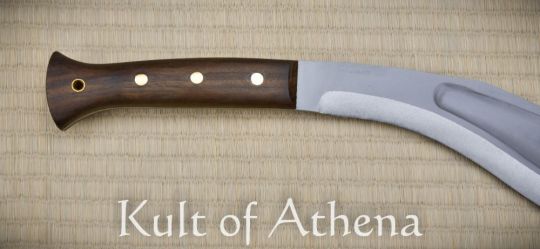


Condor – King Kukri Machete
The King Kukri machete is modeled after larger kukri examples from different regions in Nepal, and features a wide special fuller out of the middle (often referred to as a chirra) to give the large 12.6-inch blade a good amount of balance by removing some weight from its heaviest part, making this Kukuri much more lively and swift in the hand than would be expected from such a large bladed Kukri. The blade is crafted from well-tempered 1075 high carbon steel and is both tough and robust and well-capable of slicing and hacking through even very thick targets. The Kukuri is made as durable as possible by directly riveting its walnut grip scales to a very thick blade tang.
Included is a thick sheath of welted leather with buttoned retaining straps and a swivel-mounted belt loop.
#Kult of Athena#KultOfAthena#New Item Wednesday#knife#knives#Knives & Daggers#Modern Tactical Swords#Korean Philippine & S.E. Asian Weapons#Korean Philippine & S.E. Asian Knives & Daggers#Modern Knives#Modern Weapons#Tactical Knives#Tactical Weapons#khukuris#Kukris#Asian Knives#Asian Weapons#new item#new items
2 notes
·
View notes